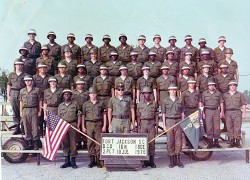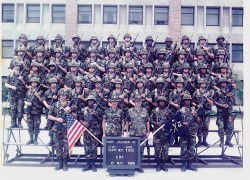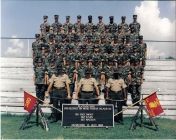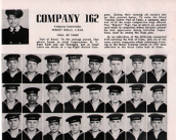The infantry is the main land combat force and backbone of the Army. It's equally important in peacetime and in combat. The Infantryman's role is to be ready to defend our country in peacetime and to capture, destroy and repel enemy ground forces during combat.
11B1O - Skill Level One




Driver: The driver drives the vehicle under the VC's control. He follows terrain-driving procedures and tries to select hull-down positions. He also aids in detecting targets and observing rounds fired. He assists in navigation by monitoring odometer readings and observing terrain. The driver is primarily responsible for operator maintenance of vehicle automotive systems.
Ratelo: The radio telephone operator operates and performs maintenance on his assigned radio to include preparation for special operations (cold weather, air assault, or waterborne) and the construction of field-expedient antennas. He must understand the platoon/company mission. In the event the platoon leader/commander becomes a casualty, the RATELO may be the only man on the radio for a time. If so, he must be prepared to call for and adjust artillery or to request medical evacuation or re-supply. He may assist in OPORD preparation by copying overlays and building a sand table.
Rifleman: Each infantry squad has two riflemen. Each rifleman is equipped with an M16A4 or M4. One rifleman is designated as the anti-armor specialist (see below). The other rifleman in each squad is assigned the M240B under an "arms room" concept, meaning that the leader will decide which weapon to employ resulting from an analysis of the factors of METT-TC.
Gunner: The gunner observes the battlefield to detect enemy targets. He operates the turret weapons as directed by the BC to engage and destroy targets. When only two men remain in the BFV, which occurs rarely, he serves as BC. He bears the responsibility for performing unit-level maintenance on the turret and its weapons systems. He also helps with navigation and with radio operation.
Grenadier: The grenadier is equipped with an M203 weapon system consisting of an M16 rifle and an attached 40-mm grenade launcher. The M203 allows him to fire high explosive rounds to suppress and destroy enemy infantry and lightly armored vehicles. He also can employ smoke to screen and cover his squad's movement, fire, and maneuver. During night and adverse weather conditions, the grenadier also may employ illumination rounds to increase his squad's visibility and mark enemy or friendly positions. The grenadier provides the fire team with an indirect fire capability out to 350 meters.
Anti Armor Specialist: Although normally equipped with an M4 within one of the fire teams of a rifle squad, the squad anti-armor specialist is capable of defeating heavy armor in any tactical environment. The squad anti-armor specialist is equipped with the Javelin AT missile system. This system provides the squad, platoon, and company with an extremely lethal, fire-and-forget, man-portable, top-attack anti-armor capability to defeat enemy main battle tanks during day, night, and adverse weather conditions at ranges up to 2,000 meters. If required, the squad anti-armor specialist destroys enemy armor threats that may impede the squad and platoon's progress.
Ammo Bearer: The first and second ammunition bearer carries and prepares the ammunition
Machine gunner: Machine gun may be used in several ways: In the defense to make use of its heavy firepower in final protective fires when used with a tripod and T&E mechanism and in areas that offer a dismounted avenue of approach into the position.
Sniper: Builds a steady, comfortable position. Locates and identifies the designated target. Estimates the range to the target. Dials in the proper elevation and windage to engage the target. Notifies the observer of readiness to fire. Takes aim at the designated target. Controls breathing at natural respiratory pause. Executes proper trigger control. Follows through. Makes an accurate and timely shot call. Prepares to fire subsequent shots, if necessary.
Ratelo: The radio telephone operator operates and performs maintenance on his assigned radio to include preparation for special operations (cold weather, air assault, or waterborne) and the construction of field-expedient antennas. He must understand the platoon/company mission. In the event the platoon leader/commander becomes a casualty, the RATELO may be the only man on the radio for a time. If so, he must be prepared to call for and adjust artillery or to request medical evacuation or re-supply. He may assist in OPORD preparation by copying overlays and building a sand table.
Rifleman: Each infantry squad has two riflemen. Each rifleman is equipped with an M16A4 or M4. One rifleman is designated as the anti-armor specialist (see below). The other rifleman in each squad is assigned the M240B under an "arms room" concept, meaning that the leader will decide which weapon to employ resulting from an analysis of the factors of METT-TC.
Gunner: The gunner observes the battlefield to detect enemy targets. He operates the turret weapons as directed by the BC to engage and destroy targets. When only two men remain in the BFV, which occurs rarely, he serves as BC. He bears the responsibility for performing unit-level maintenance on the turret and its weapons systems. He also helps with navigation and with radio operation.
Grenadier: The grenadier is equipped with an M203 weapon system consisting of an M16 rifle and an attached 40-mm grenade launcher. The M203 allows him to fire high explosive rounds to suppress and destroy enemy infantry and lightly armored vehicles. He also can employ smoke to screen and cover his squad's movement, fire, and maneuver. During night and adverse weather conditions, the grenadier also may employ illumination rounds to increase his squad's visibility and mark enemy or friendly positions. The grenadier provides the fire team with an indirect fire capability out to 350 meters.
Anti Armor Specialist: Although normally equipped with an M4 within one of the fire teams of a rifle squad, the squad anti-armor specialist is capable of defeating heavy armor in any tactical environment. The squad anti-armor specialist is equipped with the Javelin AT missile system. This system provides the squad, platoon, and company with an extremely lethal, fire-and-forget, man-portable, top-attack anti-armor capability to defeat enemy main battle tanks during day, night, and adverse weather conditions at ranges up to 2,000 meters. If required, the squad anti-armor specialist destroys enemy armor threats that may impede the squad and platoon's progress.
Ammo Bearer: The first and second ammunition bearer carries and prepares the ammunition
Machine gunner: Machine gun may be used in several ways: In the defense to make use of its heavy firepower in final protective fires when used with a tripod and T&E mechanism and in areas that offer a dismounted avenue of approach into the position.
Sniper: Builds a steady, comfortable position. Locates and identifies the designated target. Estimates the range to the target. Dials in the proper elevation and windage to engage the target. Notifies the observer of readiness to fire. Takes aim at the designated target. Controls breathing at natural respiratory pause. Executes proper trigger control. Follows through. Makes an accurate and timely shot call. Prepares to fire subsequent shots, if necessary.
11B2O - Skill Level Two

Team Leader: This soldier is a fighting leader who leads by personal example and helps the squad leader as required. He controls the movement of his fire team and the rate and placement of fire by leading from the front and using the proper commands and signals. He maintains accountability of his sAssistant Operations Sergeantoldiers and equipment. He ensures his soldiers maintain the unit standards in all areas. Recommend 24 months as a team leader to hone technical and tactical proficiency.
BFV Gunner: The gunner observes the battlefield to detect enemy targets. He operates the turret weapons as directed by the BC to engage and destroy targets. When only two men remain in the BFV, which occurs rarely, he serves as BC. He bears the responsibility for performing unit-level maintenance on the turret and its weapons systems. He also helps with navigation and with radio operation.
Anti Armor Squad Leader: The squad leader is responsible for the discipline and training of his squad and the maintenance of his equipment. He is skilled in all aspects of his weapons systems. He employs his squad in accordance with orders from the section leader. He detects and identifies targets, issues fire commands, and controls the fires and movement of his squad.
Sniper Team Leader: Snipers work and train in 2-man teams. One sniper's primary duty is that of the sniper and team leader while the other sniper serves as the observer. The sniper team leader is responsible for the day-to-day activities of the sniper team. His responsibilities are as follows:
(1) To assume the responsibilities of the Sniper Squad Leader that pertain to the team in the Sniper Squad Leader’s absence.
(2) To train the team.
(3) To issue necessary orders to the team.
(4) To prepare for missions.
(5) To control the team during missions.
BFV Gunner: The gunner observes the battlefield to detect enemy targets. He operates the turret weapons as directed by the BC to engage and destroy targets. When only two men remain in the BFV, which occurs rarely, he serves as BC. He bears the responsibility for performing unit-level maintenance on the turret and its weapons systems. He also helps with navigation and with radio operation.
Anti Armor Squad Leader: The squad leader is responsible for the discipline and training of his squad and the maintenance of his equipment. He is skilled in all aspects of his weapons systems. He employs his squad in accordance with orders from the section leader. He detects and identifies targets, issues fire commands, and controls the fires and movement of his squad.
Sniper Team Leader: Snipers work and train in 2-man teams. One sniper's primary duty is that of the sniper and team leader while the other sniper serves as the observer. The sniper team leader is responsible for the day-to-day activities of the sniper team. His responsibilities are as follows:
(1) To assume the responsibilities of the Sniper Squad Leader that pertain to the team in the Sniper Squad Leader’s absence.
(2) To train the team.
(3) To issue necessary orders to the team.
(4) To prepare for missions.
(5) To control the team during missions.
11B3O - Skill Level Three

Rifle Squad Leader: This soldier is responsible for all that the rifle squad does or fails to do. He is a tactical leader and, as such, leads by example. The rifle squad leader--
(1) Controls the maneuver of his squad and its rate and distribution of fire.
(2) Trains his squad on the individual and collective tasks required to sustain combat effectiveness.
(3) Manages the logistical and administrative needs of his squad. He requests and issues ammunition, water, rations, and special equipment.
(4) Maintains accountability of his soldiers and equipment.
(5) Completes casualty feeder reports and reviews the casualty reports completed by squad members.
(6) Submits requests for awards and decorations.
(7) Directs the maintenance of the squad's weapons and equipment.
(8) Inspects the condition of soldiers' weapons, clothing, and equipment.
(9) Ensures that material and supplies are distributed to the soldiers in the squad.
(10) Keeps the platoon sergeant/leader informed on squad supply status and squad requirements.
(11) Ensures supplies and equipment are internally cross-leveled within the squad.
Sniper Squad Leader: Sniper teams should be centrally controlled by the Sniper Squad Leader. The Sniper Squad Leader is responsible for the command and control of snipers assigned to the unit. The duties and responsibilities of the Sniper Squad Leader are as follows:
(1) To advise the unit commander on the employment of snipers.
(2) To issue orders to the team leader.
(3) To assign missions and types of employment.
(4) To coordinate between the sniper team and unit commander.
(5) To brief the unit commander and team leaders.
(6) To debrief the unit commander and team leaders.
(7) To train the teams.
(1) Controls the maneuver of his squad and its rate and distribution of fire.
(2) Trains his squad on the individual and collective tasks required to sustain combat effectiveness.
(3) Manages the logistical and administrative needs of his squad. He requests and issues ammunition, water, rations, and special equipment.
(4) Maintains accountability of his soldiers and equipment.
(5) Completes casualty feeder reports and reviews the casualty reports completed by squad members.
(6) Submits requests for awards and decorations.
(7) Directs the maintenance of the squad's weapons and equipment.
(8) Inspects the condition of soldiers' weapons, clothing, and equipment.
(9) Ensures that material and supplies are distributed to the soldiers in the squad.
(10) Keeps the platoon sergeant/leader informed on squad supply status and squad requirements.
(11) Ensures supplies and equipment are internally cross-leveled within the squad.
Sniper Squad Leader: Sniper teams should be centrally controlled by the Sniper Squad Leader. The Sniper Squad Leader is responsible for the command and control of snipers assigned to the unit. The duties and responsibilities of the Sniper Squad Leader are as follows:
(1) To advise the unit commander on the employment of snipers.
(2) To issue orders to the team leader.
(3) To assign missions and types of employment.
(4) To coordinate between the sniper team and unit commander.
(5) To brief the unit commander and team leaders.
(6) To debrief the unit commander and team leaders.
(7) To train the teams.
11B4O - Skill Level Four

Rifle Platoon Sergeant: This soldier is the senior NCO in the platoon and second in succession of command. He helps and advises the platoon leader, and leads the platoon in the platoon leader's absence. He supervises the platoon's administration, logistics, and maintenance. He may prepare and issue paragraph 4 of the platoon OPORD. The rifle platoon sergeant is responsible for individual training. He must ensure that soldiers can perform their individual MOS tasks. He advises the platoon leader on appointments, promotions and reductions, assignments, and discipline of NCOs and enlisted soldiers in the platoon. The rifle platoon sergeant--
(1) Organizes and controls the platoon CP IAW the unit SOP, platoon leader guidance, and METT-T factors.
(2) Trains the crews and employs the platoon's machine guns IAW the platoon leader's orders, appropriate field manuals, unit SOP, and METT-T factors.
(3) Receives squad leaders' requests for rations, water, and ammunition. Works with the company's first sergeant or XO to request resupply. He also directs the routing of supplies and mail.
(4) Directs the platoon aidman and platoon aid and litter teams in moving casualties to the rear.
(5) Maintains platoon strength information, consolidates and forwards the platoon's casualty reports (DA Forms 1155 and 1156), and receives and orients replacements.
(6) Monitors the morale, discipline, and health of platoon members.
(7) Takes charge of task-organized elements in the platoon during tactical operations. This can include, but is not limited to, the following: Quartering parties/Security forces in withdrawals/Support elements in raids or attacks/Security patrols in night attacks.
(8) Coordinates and supervises company-directed platoon resupply operations.
(9) Ensures that supplies are distributed IAW the platoon leader's guidance and direction.
(10) Ensures that ammunition, supplies, and loads are properly and evenly distributed (a critical task during consolidation and reorganization).
(11) Ensures the casualty evacuation plan is complete and executed properly.
Master Gunner: The master gunner is the commander's gunnery technical advisor; he helps the commander and the staff plan, develop, and conduct gunnery training. The master gunner--
• Prepares a surface danger-area diagram and range overlay.
• Prepares scaled ranges, if required.
• Organizes range firing exercises.
• Sets up range firing exercises.Y
• Ensures proper conduct of range firing exercises.
• Supervises the Bradley crews to ensure proper boresighting and zeroing.
• Coordinates target array and layout for range firing and qualification.
• Conducts remedial training on site, as needed.
• Ensures that a standard Bradley crew evaluator program is implemented.
Operations Sergeant: The Operations Sergeant assists in organizing, and coordinating the company/battalion/brigade and supporting unit’s engineer operations. He is the noncommissioned officer in charge (NCOIC) of the operations in the absence of the Executive/Operations Officer. The Operations Sergeant advises the Company/Battalion/Brigade Commander on the current and future employment of engineers. He maintains the current operational status of the engineer unit. He organizes, deploys and supervises the field Tactical Operations Center (TOC).
Assistant Operations Sergeant: The Assistant Operations Sergeant assists the Operations Sergeant in organizing, and coordinating the brigade and supporting unit’s engineer operations. He is the noncommissioned officer in charge (NCOIC) of the operations in the absence of the operations sergeant, the assistant operations sergeant advises the Bde Commander on the current and future employment of engineers. He assists the assistant division engineer and maintains the current operational status of engineer units supporting the brigade/division.
Infantry Center/School, Fort Benning, GA
School: 809 Location: BLDG 04, FT BENNING, GA
Course: 010-11B10 (R) Phase:
Course Title: INFANTRYMAN
Class Schedule
FY: 2010 School: 809 Course: 010-11B10 (R) Phase: Course Length: 6 Weeks 3.0 Days
Provides a logical progression of individual skills and tasks, selected to develop a disciplined, motivated soldier proficient in common entry-level infantry task. Course develops self-disciplined, motivation, physical readiness, and proficiency in combat
survivability, combat techniques, individual weapons, and crew-served weapons that will enable the soldier to become a productive member of a unit. Duty-position-unique unit training will be required to fully integrate the graduate into the unit.
(1) Organizes and controls the platoon CP IAW the unit SOP, platoon leader guidance, and METT-T factors.
(2) Trains the crews and employs the platoon's machine guns IAW the platoon leader's orders, appropriate field manuals, unit SOP, and METT-T factors.
(3) Receives squad leaders' requests for rations, water, and ammunition. Works with the company's first sergeant or XO to request resupply. He also directs the routing of supplies and mail.
(4) Directs the platoon aidman and platoon aid and litter teams in moving casualties to the rear.
(5) Maintains platoon strength information, consolidates and forwards the platoon's casualty reports (DA Forms 1155 and 1156), and receives and orients replacements.
(6) Monitors the morale, discipline, and health of platoon members.
(7) Takes charge of task-organized elements in the platoon during tactical operations. This can include, but is not limited to, the following: Quartering parties/Security forces in withdrawals/Support elements in raids or attacks/Security patrols in night attacks.
(8) Coordinates and supervises company-directed platoon resupply operations.
(9) Ensures that supplies are distributed IAW the platoon leader's guidance and direction.
(10) Ensures that ammunition, supplies, and loads are properly and evenly distributed (a critical task during consolidation and reorganization).
(11) Ensures the casualty evacuation plan is complete and executed properly.
Master Gunner: The master gunner is the commander's gunnery technical advisor; he helps the commander and the staff plan, develop, and conduct gunnery training. The master gunner--
• Prepares a surface danger-area diagram and range overlay.
• Prepares scaled ranges, if required.
• Organizes range firing exercises.
• Sets up range firing exercises.Y
• Ensures proper conduct of range firing exercises.
• Supervises the Bradley crews to ensure proper boresighting and zeroing.
• Coordinates target array and layout for range firing and qualification.
• Conducts remedial training on site, as needed.
• Ensures that a standard Bradley crew evaluator program is implemented.
Operations Sergeant: The Operations Sergeant assists in organizing, and coordinating the company/battalion/brigade and supporting unit’s engineer operations. He is the noncommissioned officer in charge (NCOIC) of the operations in the absence of the Executive/Operations Officer. The Operations Sergeant advises the Company/Battalion/Brigade Commander on the current and future employment of engineers. He maintains the current operational status of the engineer unit. He organizes, deploys and supervises the field Tactical Operations Center (TOC).
Assistant Operations Sergeant: The Assistant Operations Sergeant assists the Operations Sergeant in organizing, and coordinating the brigade and supporting unit’s engineer operations. He is the noncommissioned officer in charge (NCOIC) of the operations in the absence of the operations sergeant, the assistant operations sergeant advises the Bde Commander on the current and future employment of engineers. He assists the assistant division engineer and maintains the current operational status of engineer units supporting the brigade/division.
School Information


Infantry Center/School, Fort Benning, GA
School: 809 Location: BLDG 04, FT BENNING, GA
Course: 010-11B10 (R) Phase:
Course Title: INFANTRYMAN
Class Schedule
FY: 2010 School: 809 Course: 010-11B10 (R) Phase: Course Length: 6 Weeks 3.0 Days
Provides a logical progression of individual skills and tasks, selected to develop a disciplined, motivated soldier proficient in common entry-level infantry task. Course develops self-disciplined, motivation, physical readiness, and proficiency in combat
survivability, combat techniques, individual weapons, and crew-served weapons that will enable the soldier to become a productive member of a unit. Duty-position-unique unit training will be required to fully integrate the graduate into the unit.




